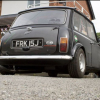At first I put everything together and had a functional clutch (pushing the car in gear with the clutch pedal depressed did not move the engine). Something evidently wasn't right though, because with the clutch pedal up the plunger in the flywheel housing was trying to turn with the engine, which was consequently impossible to turn over more than three quarters of a turn.
I took everything apart and re-examined all the parts. I discovered that the new thrust plate in the end of the diaphragm housing is different to the old one. Here is the new diaphragm housing as supplied:

And here are the two thrust plates. The one on the left came off the old diaphragm housing, the one on the right is the new one:

I know, I should have noticed before... doh. The old thrust plate has a dimple to accommodate the pin in the centre of the clutch release bearing, pictured below:

I put it all back together with the old thrust plate. Now the engine turns independently of the clutch plunger, but the clutch doesn't engage at all. The clutch arm moves, but the engine still turns with the clutch pedal depressed. I've tried adjusting the throw out stop, which makes no difference. The clutch pedal is noticeably light, which I imagine is due to it moving only the clutch arm and not rest of the clutch assembly. The clutch arm now comes to rest approx 4mm from the clutch return stop with the clutch pedal up, whereas before it sat on the return stop.
Looking at both thrust plates side by side, it's evident that the new one is raised about 4mm in the centre. When fitted, this raised part was pushing against the clutch release bearing with sufficient pressure to operate the clutch. With the old thrust plate there is an extra 4mm of space between bearing and thrust plate, so only the pin in the centre of the bearing can touch the thrust plate. It's not to be doing so with sufficient pressure though.
What's the reason for the clutch not engaging? As far as I can see, either
1) the pin in the centre of the release bearing is worn (although wearing by several mm seems unlikely)
2) I need some kind of spacer behind the old thrust plate (again, doesn't make a lot of sense as the clutch worked fine before with an identical diaphragm housing)
3) I've got major brain fade and something needs adjustment (probable)
Any ideas?
Edited by whawes, 03 March 2007 - 01:45 PM.
















